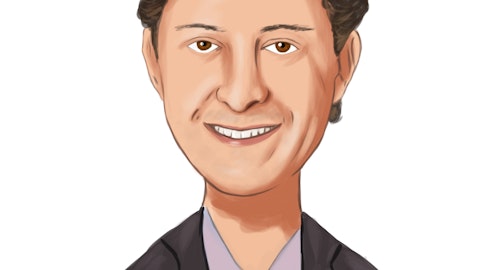Matthew Blair: Hi. Thank you, and good morning. Peter, you mentioned that you’re looking for bolt-on acquisitions in Ad Mat. Are there specific end markets where you’re looking to get more exposure? So, for example, are you looking to increase your aerospace exposure, or are you looking for perhaps more diversification?
Peter Huntsman: I think that we’d be looking for anything that’s got high margins, that we have the chemistry to be able to do something that is unique. I like to think — I mean, when we look at opportunities for acquisitions, I like to ask the question around what can we do that private equity can’t do. Our recent acquisitions, as we looked at the Gabriel acquisition, the CBC acquisition, these were great acquisitions. The previous owners were great companies, but we had an opportunity to globalize the applications, to integrate into our existing footprint, and they didn’t really go into any one specific downstream application as much as they — I’d say there was more of a horizontal growth. We went out rather than up and down on that integration.
So, I think where we can continue to bring technology, to bring globalization and to bring downstream applications and uniqueness to our customers, solutions to our customers, we’re going to be focused on those. But no, we don’t have a specific where we’re saying we’re going to put a greater emphasis on aerospace, for example.
Matthew Blair: Sounds good. And then, could you talk about your MDI supply expectations for the next few years? There’s been some reports that Wanhua is starting up a new 400 kt expansion this quarter. Is that in line with your expectations? And are there any other big projects on the docket for the rest of this year or into 2025?
Peter Huntsman: Yeah. I think after that expansion from Wanhua comes on, I’m not sure there’s a whole lot of capacity coming behind that. But look, I mean, Wanhua is going to do what they’re going to do. But, I mean, as I look — the Chinese market continues to be a good market for us. Demand is continuing to modestly grow and pricing continues to be pretty sticky. And so I don’t see any new capacity coming on in North America or Europe. If anything, I question if everything ought to be operating in those two market segments, but as you look outside of China, there’s nothing coming on.
Operator: Thank you. Our next questions come from the line of Mike Harrison with Seaport Research Partners. Please proceed with your questions.
Mike Harrison: Hi. Good morning. Another question for you on the spray foam opportunity. Was wondering if you could talk about progress that you’re making on some commercial inroads in Europe and in Asia. You mentioned that maybe there are some opportunities in building insulation in China, and just curious how you’re positioned there?
Peter Huntsman: Yeah. So, this is going to be an area that we’re going to continue to put a lot of emphasis on. And you look — just beyond Asia, you look at specifically in Japan and some of these other areas, the Middle East, we’re seeing stronger growth there than in other areas of those regions. I see this as a real opportunity. And as you think around the — either the high cost of energy, as in the case of Japan, or in the Middle East, where there’s just a lot of new construction that’s going on, these are both prime areas of opportunity for us. But I should emphasize that as you look at the vast, vast majority of that business is North America, Canada, and the US related. We are going to see growth in Europe and Asia, but the health and the vitality of that business is going to be dependent on North America.
Mike Harrison: All right. And then a question for Phil and I apologize if this is a stupid question, but was curious if you can give us some color on the special items, the gain on acquisition of assets and the prepaid asset write off. What were those two items and were they related to each other?
Phil Lister: They were related to each other, Mike. You’re quite right. That was all related to the closing of the SLIC transaction, the SLIC restructuring that we did. And you’ll see a number of $71 million, you’ll see a number of $52 million. There’s also a number of $18 million on tax. And when you net all those together, you get virtually a no movement whatsoever on net income. So, it all relates to the SLIC transaction with minimal impact to net income.
Operator: Thank you. Our next questions come from the line of Arun Viswanathan with RBC Capital Markets. Please proceed with your questions.
Arun Viswanathan: Great, thanks for taking my question. So, I just wanted to come back to the discussion around normalization of some of these markets. So, if you think of maybe the first half around $200 million-plus of EBITDA, and maybe the second half above that, you’re kind of tracking around $450 million, $500 million. And I think in the past, your peak EBITDA was around $1.4 billion. If you remove some textiles, maybe you’re down to $1.3 billion. So, is that the right range you’re kind of thinking of? And so, if you think about that going from $450 million to $500 million to maybe $800 million or $900 million in the mid-cycle, is that maybe two-thirds volume and maybe one-third price? How would you kind of frame that trajectory?
Phil Lister: I’m not sure, Arun, that you’re off that much in any one area. I do think that maybe you’re going to see a little more pricing. You said you’re kind of a third — two-thirds, one-third on price and volume, I think it’s got to be probably pricing just has to occur here. We need to be able to get traction to offset higher raw material prices and margin recovery. Volume is only going to take so much of that. So, we need the volume to get the price. That’s got to come first. But I would be the optimist that I am, I hope that we would do better in ’24. I hope that we have a stronger second half in ’24. But having said that, since you look at kind of your mid cycles peak and where we are today, no, I don’t think you’re too far off.
Arun Viswanathan: Great. Thanks for that. And then just going back to the question of portfolio, arguably, despite some maybe improving markets here, the cost position in Europe is probably not necessarily going to get materially better. So, would you be in a position to maybe reconsider some exits in Europe at some point in the future? Obviously, we have seen some announcements in certain areas by some of your competitors already. So, just wanted to get your thoughts on that.
Peter Huntsman: No, I think that as we look at Europe, look, I’m concerned about a lot of things in Europe, but I’m mostly concerned about high energy prices in the high regulatory environment. As I look at the high energy cost, most of our businesses in Europe are not terribly energy intensive assets. So, again, I maybe have some concerns around the macro picture, but of our individual assets, I think that by and large, they’re competitive. I look at Advanced Materials, and that continues to be a very strong business for us with — we see stronger margins in Advanced Materials than we do in the other areas of the world. And between Europe and APAC, we have a much larger business in Europe than we do APAC. So, again, if you’re in the right segments, aerospace, adhesion, light weighting, you’re going to do okay in Europe.
If you’re in energy intensive and you’re producing fertilizers, which we’re not, glass and things, cement things that are going to be energy intensive, I think, you’ve got some real portfolio concerns there. So, the cost competitiveness of Europe versus North America and Asia right now in polyurethanes does not warrant the movement of large scale shipments to be moving around the globe at this time. So this is — obviously, that’s where we were a year ago. We’re not there today. I think energy prices are still too high in Europe. I think — I don’t think they’re adequately being addressed by the government there. I don’t think they have a realistic policy to address those things. But I don’t see that as being bad enough to force an exit.
Operator: Thank you. We have reached the end of our question-and-answer session. And with that, that does conclude today’s teleconference. You may disconnect at this time. Thank you for your participation, and have a great weekend.
Follow Huntsman Corp (NYSE:HUN)
Follow Huntsman Corp (NYSE:HUN)
Receive real-time insider trading and news alerts


